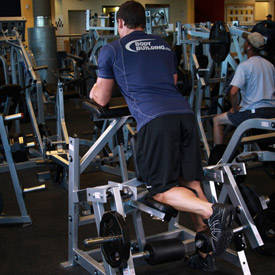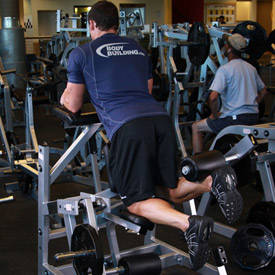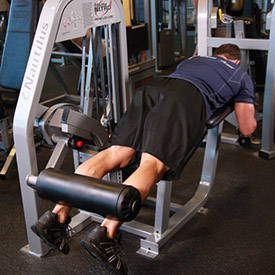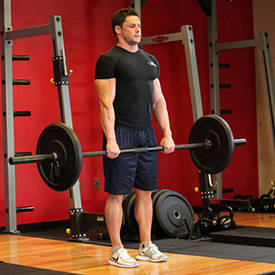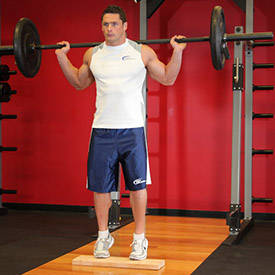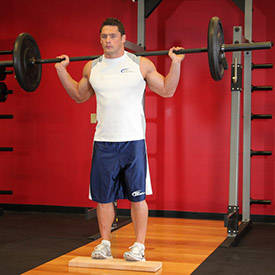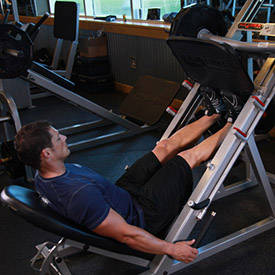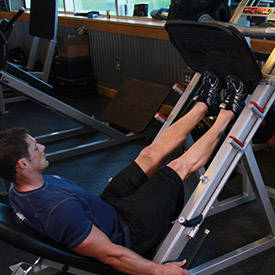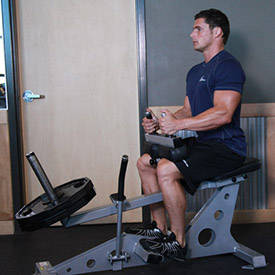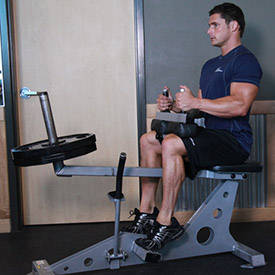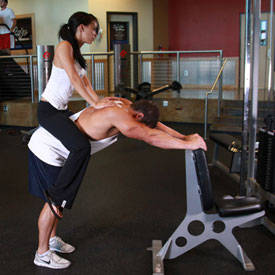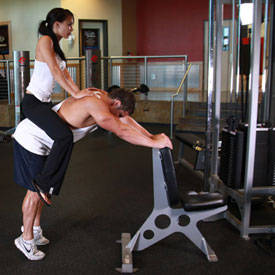| Article Summary: |
It may look like the quads are all there is to leg training and it's true that the majority of bulk and definition is situated in the front of the upper leg, but when looking a bodybuilder from the side or rear you'll notice that the quads hardly cover all your needs. If your hamstrings are weak you will notice it. You can't get away with such weaknesses. The hamstrings carry a lot of the weight when standing or walking, even though the quadriceps do the bulk of the work.
They stop you and slow you down when running, catch the shock of every step and keep you upright while you are standing. If you've ever had an injury in the area you'll know how gruesome it is to have to rest such an important muscle. Injuries resulting from weaknesses in the hamstrings are the number one cause of injury in lots of stop-and-go sports like tennis. So for your safety and aesthetics, train the hamstrings.
And of course what use is having gigantic quads if you have no calves. That makes you look like you are supporting all that muscle on chopsticks. Strong calves can cover up weak quads to a point, but not the other way around. The bigger your quads the more deficiencies in the lower leg will show. The calves should be as big, or bigger than the arms.
Meaning if you are working towards 20-inchers, you better pay some attention to your calves for the sake of symmetry. Calves show someone you are not the type to sit around, it shows you are a hard worker who has been places and is going to make it. Large calves are the typical trademark of a jock (except for basketball players, they have small calves): soccer - and football-players, surfers, skaters and so on.
So when you can stand next to those guys and make them pale in comparison you have a one up on most competitors. Great calves are like a calling card. Mike Matarazzo for example, has such great calves that sometimes people forget he has a great body, they just remember those incredible calves that stick out a mile away...
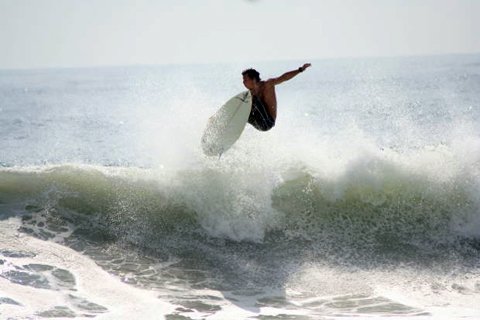
 Click To Enlarge.
Click To Enlarge.
Large Calves Are A Tradmark Of Athletes Like Soccer
Players, Football Players, Surfers, And Skaters.

Keep Breathing
-
Like when training the quads, you'll need to keep reps as high or higher. These are both muscle-groups that are used a lot, especially calves, because even in a single day you can walk several miles. That makes for heaps of slow-twitch fibers. And to hit those we'll need to train in an oxidative fashion and increase the number of trainings. For hamstrings reps ranging from 10 to 20, just like for quads, are probably your safest bet.
Odds are there is some fast fiber in their too, and stimulating that will deliver results on a shorter term than training the slow fiber alone. Calves on the other hand respond best to reps going from 20 to 40, with lots of weight. The more the better. Both of these muscles provide problems for many a trainee. You wouldn't expect them to because the choice of exercises is extremely limited, they don't require endless sets and they aren't such complex muscles either. The problem, all too often, is the rep range, the frequency of training and the intensity of training, so let's have a look at some of these things.
|
|
|
|
|

Splitting It Up
-
Most people train legs as a whole, and combine hamstrings and quads. Usually that means hams are relegated to the end of the workout, leaving them in a ditch. After having trained quads with exercises like leg presses and squats, there is no way you can invest any intensity in your hamstring work. I don't know about you, but I wouldn't even want to.
So you have two options, the time-consuming way of adding a separate workout for hamstrings, or switch them up. Train hamstrings first one week, quads first the next week. Whichever way you go, increase the focus and intensity you put into hamstring work.
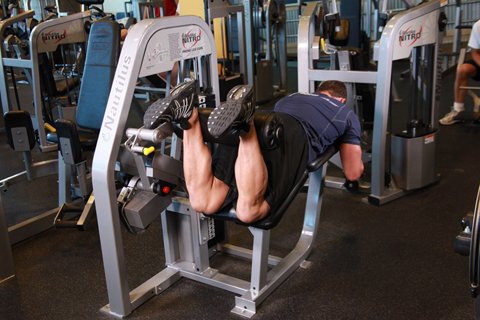
 Click To Enlarge.
Click To Enlarge.
Whichever Way You Go, Increase The Focus
And Intensity You Put Into Hamstring Work.

Increase The Frequency
-
Hamstrings can benefit from a little more work, but this remark is directed towards calf training. Hitting calves once every two weeks when you feel like it, with 20 sets, will do absolutely nothing. Your calves are under that kind of tension all day every day and will not even be tickled by such an approach. To be correct you'll need to hit them at least once or twice a weak with 6 to 8 very intense sets, lots of weight, very high reps and all you've got.
Naturally this brings back up the issue of concentration as in the last point. To overcome this use the principle of staggered sets described in the intensity chapter. Pick three days, say Monday, Wednesday and Friday. No matter what muscle you are training, between two heavy sets, don't just sit around and do nothing, hit your calves with a nice 30-rep set with a few plates on the calf raise or donkey raise. This will get you to 8 sets in no time, you won't waste any extra time and you are sure to get in all the necessary work with proper concentration.
This is the way I brought up my calves. Training for football in the States we had a bear squat station, and I loved to train calves on it, so I would sneak in sets when waiting for another machine or station. Within 5 months I had added a full 2 inches to my calves. Previously the lagging muscle, now I have to work to get my arms up to par with my calves, and my arms, as you know, have a fair size.
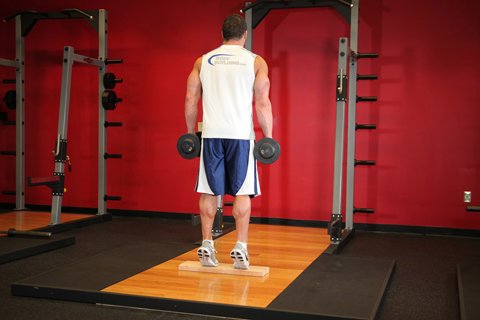
 Click To Enlarge.
Click To Enlarge.
You Need To Hit Your Calves Once Or Twice
A Week With Six To Eight Very Intense Sets.

Decrease The Weight Increase The Mind/Muscle Connection
-
...for hamstrings. Use correct form on curling exercises, with a weight that allows you to really feel the contraction on each of your reps, whether it is ten or twenty. Really get into it and feel it, this will increase the mind/muscle connection. As with training back this is important for the hamstrings since they are not plainly visible as you work them. So feeling them, imagining them getting larger, loving the pump, longing for every rep, all these things will help you get into training hams and getting the most out of them. So don't exaggerate the weight if you want to pay attention to such details...
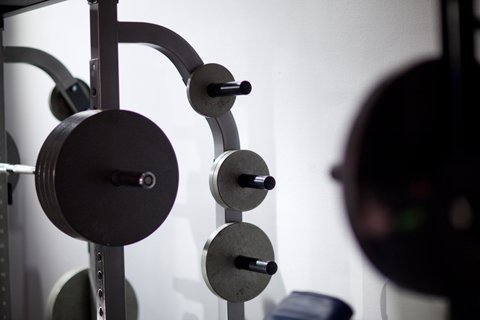
 Click To Enlarge.
Click To Enlarge.
Use A Weight That Allows You To Really Feel
The Contraction On Ten To Twenty Reps.

Increase The Weight
-
...for calves. The high reps are confusing and people often use a weight that is about half of what they can handle. The calves thrive on intensity. Form can be very important, so can rep speed, but calves will respond to short explosive reps. The key here is weight, intensity and keeping the pressure on as long and hard as you can. Considered by most standards, the way I brought up my calves is incorrect.
I did my reps way to fast, missed at least 20 percent of my full range of motion and did too many sets. Now don't rush out and copy all my bad habits because it worked for me, genetics do play a role. But the point I'm making is that you need serious weight and constant pressure to shock the durable calves into new growth.

Physiology Of The Hamstrings
-
Like its front-of-the-leg counterpart the quadriceps, the hamstrings have 4 different heads. First of all the outer two heads that make up the biceps femoris, or the biceps of the upper leg. These have most of the contractile tissue when curling the leg and require good contraction on curls if you desire full development of the upper part of the hamstrings.
Next to the biceps is the middle head or semimembranosus and way to the inside is the semitendinosus and together these two compound most of the shocks your leg receive when walking or running.Some would also add the gracus, sartorius and adductor magnus, but the working of these muscles has been added to the quads since we discussed adduction and abduction machines. These are small muscles and don't add a lot in terms of size.
|
|

Physiology Of The Calves
-
There are two basic muscles to the calves, namely the gastrocnemus inner head and the gastrocnemus outer head. They are located at the top rear end of the lower leg, near the knee where the bulk of the mass is and they move the foot up and down and in rotation. Small muscular tissue, mostly insertions are also attached to the soleus beneath. The muscle to the front of the lower leg that doesn't get a whole lot of attention is called the tibialis, which has an anterior and posterior part, but the anterior part makes up the larger piece.
The foot moves up and down by playing the tibialis and gastrocnemus muscles against each other and you can move a foot sideways by counteracting the inner and outer portions. By combining these actions the foot can rotate. Obviously the focus will be on the gastrocnemus muscles since they make up over 70 percent of the lower leg. To train these you need the typical calf exercises.

Training The Hamstrings
-
You don't have a lot of choice in training the hamstrings. Only two exercises really come to mind when you think of working the back of the leg. The first, as with the biceps brachii, is to curl the leg since the hams are sixty percent biceps as well. For this there are three different ways: either you have access to a
standing or
lying leg curl, or you do lying dumbbell curls.
A standing leg curl has the benefit of being able to really feel the contraction in the top of the leg if you manage to stay strict and use a weight that allows you to go all the way to the top for all your reps. Cheating doesn't pay at all in this exercise. Place the knee properly and securely against the pad, try to secure the upper legs and upper body in a locked position that will keep you from moving the upper leg past perpendicular and thereby endangering the contraction. Curl the leg from a straight position until your heel reaches your behind and then lower slowly. Focus on every rep.
 Click Image To Enlarge.
Click Image To Enlarge.
Standing Leg Curl
Click Here For A Video Demonstration Of Standing Leg Curl.
-
The lying leg curl allows you to hit the contraction better since your body is locked by gravity. So you can handle more weight. The difference is that the heaviest point is in the middle, as with a barbell curl, and not near the top of the rep. You can't do much wrong on this one, but try to keep everything as still as possible so that only the lower legs do the work.
-
Of course it happens that you enter small, primitive gyms and realize that you don't have a leg curl machine at your disposal of any kind. Then your only option is the lying dumbbell leg curl. Do not, under any circumstance, attempt to do this without a spotter that can accompany the dumbbell over the entire range of motion on every single rep. You will be holding the dumbbell with your feet and this is not a secure position. If you do this alone, all it takes is an inch over the necessary point and you can land a heavy dumbbell on the lower back and end your training days.
Lay on a bench, upper legs flat on the bench with the knees right on the end. Suspend your upper body on your elbows, this will keep your body in a secure position. Have your spotter put the dumbbell between your feet and keep his hand under it throughout the set. Simply curl the weight up to a point past 90 degrees but not too far since a loose dumbbell slips easily. I prefer machines, a variation between standing and lying leg curls, but if you have no other option, the dumbbell curl is still better than nothing.
The other exercise for the hamstrings is the stiff-leg deadlift. This is a form of fascial stretching and isometric exercise because you are working the muscle in the opposite point of contraction. By stretching the legs in simpler terms. Load up a barbell and hold it in your hands, use any grip you please. With legs almost straight, but not all the way since that is bad for the knees, bend at the waist keeping your back straight.
 Click Image To Enlarge.
Click Image To Enlarge.
Stiff-Legged Barbell Deadlift
Click Here For A Video Demonstration Of Stiff-Legged Barbell Deadlift.
-
Go as low as you possibly can, if you can reach the floor, stand on a platform, whatever works. Until you feel a really deep stretch and stay there for a few counts before coming back up again. Electrograms have shown these to be more effective than the leg curl and its variations. Naturally you'll need a strong lower back because bending at the waist puts the strain there first and only after midpoint does it shift to the hamstrings. Hold the stretch, that is the most important thing.
One of the better ways to train your hamstrings is to use superset of standing leg curls one week, lying leg curls the next, and stiff-leg deads. About four or 5 of them, with 10-15 reps for each exercise. So each set is about 20-30 reps. Supersetting them gives you better concentration and allows you to focus better because you perceive it as 5 sets instead of 10, but you still do the same work.

Training The Calves
-
Again there isn't much room for creativity in training the lower legs. The body goes up, the body goes down and that is it. But this one has more variations and that makes it a lot more fun to train. The fun thing about training calves is that you can hit them with very few sets, heavy weight and lots of reps, but unlike abs for example they respond very well to the amount of reps, giving you a great sensation in the core of the muscle.
The basic motion for the calves is pushing the body up on the toes, emphasized by standing on a small platform to let the heels drop down further so that you have a deeper stretch. The most basic way of doing this, is by putting a barbell on your shoulders, maybe a smith machine because of the extreme weight used in calf training, and a small one or two inch plank under the ball of the foot. With the heels barely off the floor raise yourself up as high as you can, stay there for a count and lower again. The proper way is to do it slow and strict, but as you near the last reps you can get just as much stimulation from fast, top-motion reps.
 Click Image To Enlarge.
Click Image To Enlarge.
Standing Barbell Calf Raise
Click Here For A Video Demonstration Of Standing Barbell Calf Raise.
-
You can also do this on a
leg press machine, putting the ball of your foot on the bottom of the weighted platform. Let the weight come back so your toes are pointed up at you, then push out pushing your toes as far away from you as possible. You can also do it on the stairs with a dumbbell in one hand, and keeping steady with the other. If you have a bear squat station that will work too, and some specially designed machines like the seated calf raise machine or a donkey raise machine.
 Click Image To Enlarge.
Click Image To Enlarge.
Calf Press On The Leg Press Machine
Click Here For A Video Demonstration Of Calf Press On The Leg Press Machine.
-
All are based on the same principle except the positioning of the weight is different. Only the
seated calf machine has the benefit of placing the stress more directly on the calves. The motion remains the same however. And if you want to get really medieval you can do
donkey raises the old-fashion style.
 Click Image To Enlarge.
Click Image To Enlarge.
Seated Calf Raise
Click Here For A Video Demonstration Of Seated Calf Raise.
-
Bend over, hold on to a bar or support yourself on a bench and have a few people sit on your back and a few more pushing you down. Call it a group activity. Fun to watch, fun to do. Just make sure nobody is pushing you down standing close behind you, that may give the wrong impression to some gym members of another sexual preference.
 Click Image To Enlarge.
Click Image To Enlarge.
Donkey Calf Raises
Click Here For A Video Demonstration Of Donkey Calf Raises.
-
Of course the calves are multi-faceted muscles that need strain from different angles. This can be achieved with all the exercises mentioned above. You need to split up your reps per set, 20 to 40, over three different angles. Hit the outside by pointing the toes in, hit the overall muscle by pointing toes straight forward (best done if you keep feet together) and hit the inside of the gastrocnemus with toes pointed out.
Switch up your angles doing one first in one set, another in the next set and so on. Don't keep track. Keep it fun by going by the feel. Do toes-in until the outer calves are worn, then do toes-in for as long as you can and then point toes forward to get the last of the reps you need to complete the set. On the next set start with toes out, on the next one with toes forwards and so on. Just keep switching it up to let the muscle guess. This is the best way of training a muscle that handles stress as well as the calves.
The tibialis is usually not trained separately since they are a small muscle that get stimulated when doing squats and calf raises. If you feel you need a bit of extra power in the area, try rocking back and forth on your heels and see how you like that...

Weaker Areas
-
Granted these aren't the first muscles you had in mind when you were first bitten by the iron bug, but weaknesses here too can deprive you of the full benefit of a proportional body full of muscles. The hamstrings are 33 percent of your leg size and not just lack of size is detrimental. No definition in the back of the legs is a disease many competitors have to deal with since its one of the last things to come out on a diet.
Not to mention its very hard to cut up when training because of your limited options. And this particular disease can take away from your all your back poses because it looks like you have a big smooth gap between your calves and glutes. The best solution is just to keep working them. The more mass you have in the area the less fat and water you'll pack on in the area. And it will bring out the qualities to the fullest.
|
|
|
|
|
-
A weakness in the calves is more obvious because they are the extent of your lower leg. Lower legs that are barely half the size of your arms will definitely stand out. Your calves can be high or they can be long, it's a genetic thing and it depends whether or not you get judges that like your style of calves. The thing is, sometimes that can be forgiven, but lack of size is frowned upon by all. Beach combers may think that this muscle doesn't matter to them, but the beach babes think one of the sexiest body-parts on a man is pair of bowling-ball size calves.

Progression Of Training
-
Well, what is progression? It sure doesn't mean adding exercises in this case. For calves progression is rather easy. It means the better your recuperation the more sets you can do. If you take my advice and use the staggered set approach that means you can do as many sets as you do in that workout, and this three times a week. The calves love hard work, so as long as you feed them right they will reward you with growth. And one benefit only calves and lats have: They can never get too big. The bigger the better.
For hamstrings, it's sad to say, but progression is usually going with the flow and using the amount of weight you can handle correctly. As long as you keep intensity high. Even a beginner will be using some 6 to 8 sets and I really see no reason to go beyond twelve as long as you do it right, so progression in that sense is limited as well. I imagine, since you do your squats as well, that as long as you keep to the rules, your hams will do fine.
It's an odd couple, the hamstrings and calves, they differ so much from other muscles and yet they show so many similarities. But inevitably every bodybuilder, save for that genetically blessed group that makes up a tenth of a percent of us, gets frustrated with his calf and ham development. What is outlined above gives you the answers if you are willing to read between the lines. The most important things is that instead of ignoring the muscles, as many do, you actually give them more work and more attention and concentration.
Recommended Articles
 |
 |
 |
| Share This Article: |

